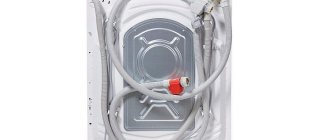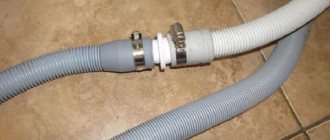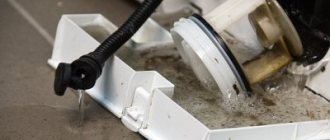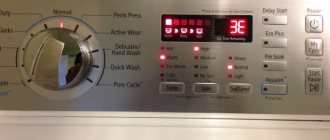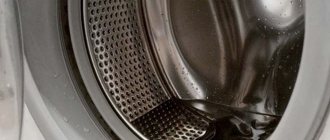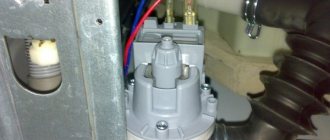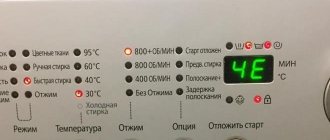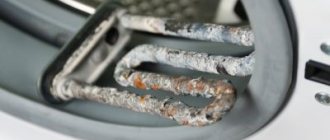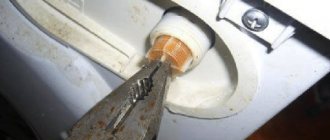Home appliances help us cope with difficult and dirty cleaning and washing at the touch of a button; it is now so pleasant to restore cleanliness and comfort. Breakdowns or malfunctions of a vacuum cleaner, refrigerator or multicooker can knock you out of your usual comfort. One of the common problems that arise at home is a clogged drain hose in the washing machine. This problem can be resolved by removing and cleaning the hose. Let's look at the causes of blockages and ways to solve this problem.
- 2 How to clean the drain hose in a washing machine
2.1 Cleaning the drain hose without dismantling
2.1.1 Use of chemicals
- 2.1.2 Citric acid
- 2.2.1 Mechanical cleaning of the removed hose
Troubleshooting yourself
Having discovered a malfunction resulting from a blockage in the drain of the washing machine, the first thing you need to do is ensure unobstructed access to the drain system.
Cleaning the filter
The filtration system is located at the bottom of the washing machine on the right side behind a small door with a hatch. To open it, you need to pry the edge of the hatch with your finger or a flat object. On some models, the panel is opened by pressing latches or bending the rotary hooks.
Behind the door there is a round filter that must be unscrewed in a counterclockwise direction.
The filter is cleaned in the following sequence:
- After unscrewing the screw, carefully remove the filter.
- Having positioned the structure at an angle, drain the liquid, first placing a container with low sides under it.
- Having freed the structure from water, remove all stuck foreign objects. If the structural elements of the system are completely covered with scale, they will have to be replaced.
- Having eliminated contaminants by washing with water and wiping with a damp sponge, inspect the location of the filtration system and remove contaminants accumulated on the walls.
- Clean the pump system, then connect the unit to the power supply and turn on the “drain” mode. If the pumping system operates correctly, the blades and rabbit will rotate smoothly.
The subtleties and nuances of cleaning a washing machine drain are presented in the video:
Dismantling the drain pipe
The flow of liquid can also be blocked if the connections to the sewer system are clogged. To clean them, you need to disconnect the hose.
The work is carried out in several stages:
- Disconnect the unit from the power supply.
- Shut off the water supply valve.
- Use a flathead screwdriver to remove the front lower or side panel.
- The remaining waste water is drained through the drain filter.
- Using pliers, disconnect the end of the hose from the siphon or sewer pipe.
In machines with vertical loading of laundry, the hose is disconnected by temporarily removing the side panel; in models with horizontal loading, options are possible
In household appliances of the Beko, Ariston, Samsung, Candy, LG, and Indesit brands, you can only get to the drainage hose through the bottom. Therefore, for convenience, it is better to place the machine on its side, having previously laid a piece of fabric under it. Unclench the clamp with pliers and disconnect the hose from the pump.
In Electrolux or Zanussi models, the hose is located along the rear wall. To access it you need to remove the back cover of the case. Having released the locking latches, you must first detach the drainage hose from the body, then unscrew the water supply hose from the valve. To completely remove the drainage hose, you need to remove the top cover of the housing, having first unscrewed the bolts holding it, and loosen the clamp securing it.
In German products, “Siemens”, “Bosch”, access to the drain hose can be obtained by removing the front part of the housing. Sequence of actions:
- Remove the rubber seal from the front of the body and remove the clamp.
- Remove the bottom panel of the housing and the drawer for detergents.
- After unscrewing the fixing bolts, remove the hatch door lock.
- Remove the front housing cover.
- Unclamping the clamp, pull out the drainage hose.
Cleaning the drain hose
Clean the drain hose by washing and treating the inner walls using a special brush. Craftsmen use for this purpose not metal, but Kevlar cable made of synthetic polymer.
The end of the plumbing cable is equipped with a small brush, which makes it easy to remove all dirt
To clean the inner walls of the pipe, the cable is inserted into the hose and moved back and forth. After this, rinse the hose with running water. If necessary, the procedure is repeated 2-3 times.
The washed hose can only be fixed in its original place, following all the steps described earlier, but in reverse order.
Tube connection diagram
In most cases, the drain hose is connected inside the washing machine directly to the pump. To clean it, you will need to disassemble the washing machine. Even if the drain is connected directly to the back wall, it is better to disassemble it, since there will be another tube from the pump itself to the back wall. From the machine, the drain pipe is connected to the sewer system.
Depending on the model of the washing machine, there are several options for accessing the pump, and therefore for removing the drain pipe:
- access through the rear wall;
- access through the bottom of the machine;
- access after removing the front cover;
- access after dismantling the side wall.
In some models there is no need to additionally disassemble the housing of household appliances. For example, some manufacturers do not cover the bottom of the machine with any plugs, and if access to the tubes is through the bottom, then in this case nothing even needs to be disassembled.
What happens if the filter is not cleaned?
A dirty trap filter creates serious problems over time:
- Unpleasant odor from the machine and washed clothes
. Debris and dirt stuck in the filter are an excellent breeding ground for germs. The dirty lump begins to sour and smell bad. The smell can penetrate into the tank, and after washing the laundry, instead of a pure aroma, receives a very unpleasant aroma. - Bad drain.
A clog in the washing machine filter prevents normal draining. If the debris is not removed in time, the filter may become so clogged that the washing machine will completely stop draining water from the tank. - Pump failure or breakdown.
There is a possibility that a foreign body may slip from the filter into the pump. This can cause the pump to jam and stop pumping water. In some cases, metal objects break the impeller blades or damage the pump body. As a result, repair or complete repair will be required.
Operating principle and system design
To know how to clean the drain system, it is recommended that you first familiarize yourself with the basic principles of its operation. The water used during the washing or rinsing process first of all enters a corrugated storage tank connected to a special cleaning filter, in which all small particles of debris accumulate.
Next, the water is discharged into the so-called impeller, after which it enters the sewer pipe. The liquid is discharged through the pressure created by the rotational force of the impeller. In accordance with these principles, almost all washing machines operate, for example, models from Atlant. A blockage can form in any of the specified areas of the system.
How to clean the drain filter in a washing machine - step-by-step instructions
We will clean the trap filter step by step, as our service technicians do.
1. For safety, turn off the water supply and disconnect the machine from the network.
You may have to lift the equipment or move it from its place. Agree that you don’t want to flood the floor with water or get an electric shock while working.
2. Find where the filter is on the washing machine and open the hatch cover, or remove the false panel from the bottom of the body. The hatch is usually fixed with a latch, and the lid is held tightly. Use a flathead screwdriver or a flat-edged cutlery knife to pry the lid open. In some models, the lid can be easily opened by hand.
The false panel is held on by latches or hooks and can be removed in two ways:
- moving towards you (sometimes you first need to pry off the top of the panel with a screwdriver)
- sideways, usually from right to left.
3. Prepare a rag and drain the remaining water from the washing machine.
Even if you used the emergency hose, a little liquid will still remain in the washing machine. To drain it completely, carefully turn the drain filter plug 45-60 degrees counterclockwise and let the remaining water drain into a nearby container or onto a rag. If the plug is additionally secured with a special screw, as, for example, in Candy Holiday 181 machines, then first loosen or unscrew it using a screwdriver.
4. Completely unscrew and pull out the filter.
For some brands, for example, AEG, LG, Electrolux, Zanussi, you first unscrew the plug, which acts as a water stopper, and then pull out the filter.
5. Clean and rinse the filter.
First, we take out large debris - wool, threads, foreign objects. Then we take a regular dish sponge with an abrasive layer and clean the surface of plaque. Then rinse the filter thoroughly under running warm water.
Be sure to check the hole in the machine and clean it of any remaining debris. At the same time, wipe off dirt and plaque with a damp cloth or sponge.
6. Check the drain pump.
Don’t forget to look into the drain pump, there may also be dirt left there. Shine a flashlight into the hole and remove any debris that has slipped into the pump. To check, rotate the impeller; nothing should interfere with its rotation.
7. Put the filter in place.
We insert it into the hole evenly, without distortions and tightly, but carefully. Tighten the filter plug clockwise. We screw in the fixing bolt, if there was one (for example, in Candy Holiday 181). In some models of AEG, LG, Electrolux, Zanussi, you must first insert the filter into the slot and then screw on the locking cover.
8.
Turn on the machine and check for leaks.
To avoid flooding the floor during washing, we check the equipment for water leakage from the filter. We put on a test rinse and see if there are any drops or streams from under the filter cover. If everything is dry, close the hatch or replace the false panel and the washing machine itself.
Information on how to properly clean the drain filter in your washing machine model is in the user manual. If you have forgotten where it is, use ours. For cleaning information, see the “Cleaning and Maintaining Your Washing Machine” section of the manual.
How to prevent blockages - preventive measures
To prevent clogging of the drain hose and prolong uninterrupted operation, you need to follow simple rules and regularly perform preventive maintenance:
- inspect pockets and remove all items from them, remove brooches and other removable jewelry from clothing;
- for fleecy and delicate fabrics, items of underwear, special covers for washing should be used;
Using special covers for washing will help prevent small objects from getting into the drain - fasten zippers, hooks and buttons on items of clothing before washing;
- choose powders and gels with the addition of salt-dissolving components or separately add hard water softeners;
- for water rich in lime and salt inclusions, it is better to install an additional filter on the incoming tube, this way you can avoid rapid overgrowth and clogging in all units of the machine.
Taking care of your home assistant, washing machine, regular maintenance and prevention will help extend the life of the unit and ensure uninterrupted and high-quality operation. Then all household chores will not be a burden, and things will shine with cleanliness and freshness after washing.
Timely preventive measures will help eliminate the need to clean the drain hose of your washing machine:
At least once every three months, it is recommended to clean the drain filter located on the front panel of the washing machine of debris. From time to time it is recommended to carry out a full wash cycle at a temperature of 90 degrees without laundry, but with soda added to the drum. Before washing, clothes must be fastened with all buttons and hooks. When washing small items in the washing machine, for example, underwear, socks, it is recommended to use special bags, otherwise there is a possibility of things getting into the drain hose. Before loading items into the washing machine, it is important to remove household debris from pockets.
How to clean a washing machine drain hose that is completely clogged
During operation, the drainage device of any washing machine accumulates small particles of dust, hair, soap solution, and threads. After a few years, the hose accumulates so much dirt that the water can hardly find its way out. What to do in such a situation and prevent a flood at home? For this purpose, the hose is sanitized.
How to rinse the drainage device of a washing machine according to all the rules?
First, turn off the cold water supply tap and disconnect the machine from the power source. Next, free the drain filter from possible residual water and disconnect the hose from the sewer. The main difficulty is disconnecting the drainage device from the body of the machine. It all depends on the model of the machine.
Next, using a thin cable with a brush at the end, clean the inside of the hose, turning the cable on one side and the other. After freeing the hose from large particles of dirt, it is washed under the tap with hot water several times. Later, all that remains is to put the device in place, secure it tightly and connect it to the sewer.
Repair of the tank pipe intended for water intake
In order to make sure that the fill valve is working, you need to get to it. The easiest way to do this is through the top panel of the machine. To do this, a pair of screws holding the cover are unscrewed, the element is moved to the rear wall, lifted and removed.
In front of us on the left in the corner there is a pipe made of rubber material connecting the fill valve and the body of the powder tray. Its ends are clamped on each side with steel clamps. To check, the pipe will have to be removed.
To do this, use pliers to loosen the clamps and move them to the center of the pipe. They can be used a second time, so there is no need to break the fasteners.
Carefully, but with some force, pull the filling pipe from the valve and from the outlet of the powder receiver. We inspect it for blockages and various damages. The pipe can be cleared of blockages using a plastic brush. After this, the part is washed and installed in its place.
Where to look for a drain pump
To clean the pump, you still need to find it inside the housing. To do this, prepare a screwdriver, a wrench, a basin with low walls (to drain water into it) and a rag.
The easiest way to find where the pump is located in a washing machine is in machines from the brands Indesit, Beko, LG, Samsung, Whirlpool, Ardo, Ariston and Candy.
In Bosh, AEG and Siemens machines
you need to disassemble the front of the machine. Necessary actions:
- Take out the powder tray and unscrew the screw.
- Open the door in the bottom panel of the machine, unscrew the screw and remove the panel.
- Unscrew the screws, remove the clamp and disconnect the cuff.
- Release the clamps and remove the housing front.
- Unscrew the screw, place a basin and drain the water, remove the pipe and disconnect the wires.
If it's Zanussi:
- Unscrew the clamps and disconnect the drain hose.
- Unscrew the screws and remove the back wall of the machine.
- Disconnect the wire terminals and unscrew the drain pump.
- Disconnect the pipes. Everything is ready for cleaning.
First you need to understand how the drainage system works.
From the drum, the liquid enters a special pipe (a thick rubber pipe), it is connected to a filter that traps most of the debris, then the water enters the pump, which drives it through the drain hose into the sewer. Anything can become clogged, but most often you have to clean the filter, so check it before removing the pump. First, you need to disassemble the pump; to do this, unscrew the screws, you will get two parts - a “snail” and a pump. Initially, it is worth inspecting and, if necessary, cleaning the pump impeller, then check the “snail”. Reassemble everything and check the machine on rinse and drain.
If nothing works, you will most likely have to change the pump.
So, for example, how to clean the pump in an LG washing machine
:
- Unplug the machine from the outlet and check if there is any water in the powder tray.
- At the bottom of the machine, find a special panel and open it with a flat-head screwdriver.
- Unscrew the screw and disconnect the filter from the housing.
- Tilt the machine back and place a basin, open the filter lid and drain the water.
- Unscrew counterclockwise and clean the filter. After this, you can check whether this contamination may have caused the breakdown; turn on the machine in the “drain” mode, you should hear the pump blades operating.
- By gently pressing and turning the pump counterclockwise, you can reach it from the bottom of the machine (it would be better to lay it on its side, if possible).
- Disconnect the wires and pipes, loosen the clamps. Everything is ready, you can clean it.
Tags
drain hose in the drain hose clogged drain hose clean the drain hose cleaning the drain hose dismantling the drain hose clean the drain hose in the washing machine in the washing machine. filling machine machine is blocked by the washing machine then the machine can be washed by the machine surface and
votes
How to restore whiteness and freshness to a toilet using folk remedies
If going to the toilet becomes unpleasant because there are noticeable stains and an unpleasant odor inside, try cleaning the toilet with a brush. If you are not pleased with the result, move on to more serious cleaning methods. Folk remedies are well suited for cleaning minor and old deposits in private houses and apartments that have a plastic pipeline or a local sewer/cesspool system.
How to clean a toilet from heavy limescale with vinegar
With prolonged exposure, vinegar can dissolve hard urinary stones and limescale without damaging the surface of the toilet.
To clean the toilet:
- Use a plunger to clean out the sewer system and pump out the water from the toilet.
- Wipe dry areas that require treatment.
- Moisten a cloth generously with vinegar and apply it to the plaque.
- After 6 hours, clean the toilet and remove any remaining residue with a non-metallic scraper.
To enhance the effect, you can use heated vinegar essence or vinegar-soda solution (1 tbsp soda for 1 tbsp acid). The processing mechanism is the same as when washing with pure vinegar.
- "Mole";
- "Mister Muscle";
Scoop the water out of the toilet, pour in the product and flush by pressing the button on the tank.
Folk remedies are no less effective: pour ½ pack of soda with 1 tbsp. water (scoop out the water from the toilet first). After 15–20 minutes, pour a kettle of boiling water into it so that the dissolved blockages go into the sewer or street cesspool.
If you have a problem with how to clean a dirty toilet, use special or folk remedies. Use aggressive ones, like hydrochloric acid and autoelectrolytes, in extreme cases, because they are dangerous for the drain system.
For complex household appliances, which includes a washing machine, preventive maintenance is necessary. Otherwise, active use will quickly damage the machine.
One type of regular equipment maintenance is cleaning the washing machine filter. It is needed for the normal operation of the drain pump. The filter serves as a barrier that protects the pump from foreign objects entering the tank, lint from fabrics, wool, hair and other debris. A clogged filter makes it difficult to pump water out of the tank and can cause pump failure.
Therefore, we have prepared an instructional article about cleaning the filter and the main problems that washing machine owners encounter during cleaning.
How to clean a drain hose that is partially clogged
This often occurs due to a clogged drainage system. There are two ways to solve this issue, and you can do it yourself. Method one is to clean the drain hose without disconnecting it from the washing machine. In case of partial blockage, when the water begins to drain more slowly, it is possible to eliminate this problem without disassembling the drainage system. This is usually caused by the settling of detergent particles and small lint and fibers that have passed through the drain filter.
There are various products available on the market to dissolve deposits that form on the inside walls of the drain hose. Before use, you must study the instructions for use, usually it is a powder or solution, sometimes found in tablet form. There is no need to worry that the use of these drugs may damage gaskets or seals. Washing machines produced by well-known global manufacturers have high quality components.
If you have doubts about the quality of the connections and gaskets, you can wash the drain hose with baking soda. To do this, you need to add 100-150 grams. soda directly into the drum and turn on the washing machine without laundry in the “cotton” mode.
If water removal from the washing machine completely stops, a second cleaning method will be required, in which you will need to completely disconnect the hose from it. For this you will need the simplest tool - a flat or figured screwdriver and pliers. The sequence of actions in this case is quite simple:
- Disconnect the washing machine from the power supply.
- Shut off the water supply.
- Carefully disconnect the hose from the machine, first placing a container to drain the remaining water.
- Disconnect the drain hose from the sewer and clean it.
To de-energize the washing machine, simply remove the plug from the socket. There is usually a tap on the hose that supplies water from the plumbing system; it should be closed. Basically, the drainage hose is attached to a pipe, which is located on the back of the washing “unit”. Using a screwdriver or pliers, you need to unclench the retaining clamp and remove it. For ease of access and operation, first place the washing machine on its side, placing a floor or other cloth under it. Sometimes users do not connect the drain to the sewer, but simply place the other end of the drain hose in the bathtub or sink.
Cleaning should be done with a Kevlar cable, at the end of which there is a small brush; you cannot clean it with metal objects. After cleaning the hose in one direction, the operation should be carried out in the other, then rinse well under running hot water.
To be more sure that the hose will not have to be removed again, it is recommended to inspect the filter as well. Perhaps it also requires revision and cleaning.
Different manufacturers have their own housing designs and filter mounts that require access. Trademarks LG, Veko, new Indesit models, the bottom is closed with a lid that can be easily removed with a flat screwdriver. Zanussi, Electrolux to access the filter you will need to remove the back panel. German manufacturers of washing machines - Bosch, Siemens - made the front panel removable. Then, depending on the design, the filter is removed. It is attached to the body using latches or a screw connection (bolt, self-tapping screws), sometimes it is screwed into the drain pipe. To dismantle it, you may need to remove the neck to which the drain hose is connected. The work must be carried out carefully, without damaging the gaskets and seals.
The filter should also be thoroughly cleaned and rinsed under running hot water. Then reassemble in reverse order. All connections must be tightened well, especially the hose clamp itself. The pressure when water comes out is small, but it is still there.
After the machine is assembled and connected to the power supply, it is advisable to wash it with a cleaning agent to completely remove small particles. In addition, you should inspect the connections for leaks and, if necessary, tighten the clamp.
For prevention, once every 1-2 months it is advisable to wash the machine to remove clogs and scale; in areas with high water hardness, use water softening agents. It is also recommended to use a special bag for washing.
https://youtube.com/watch?v=xZn7-uTPoYQ
You might be interested in
You can leave the first comment
Updates on the site
2015-2018 – All rights reserved
When copying materials, an active and indexed link to the source site is required.
Cleaning without disassembly
Natural blockages can be removed without disassembling the washing machine. This option takes less time and effort.
In addition, it is recommended to use it if the equipment’s warranty period has not yet expired. The main method of combating drain hose contamination is the use of chemicals.
Scale dissolving agents are used as substances that will help deal with blockages. They can be purchased at household chemical stores and supermarkets.
Algorithm of actions:
- Cleaning agent should be added to the powder receptacle in the required amount recommended by the manufacturer.
- Then select the washing mode with the highest water heating temperature.
- If possible, cancel the spin function and start the program.
- When finished, turn on the wash cycle again to remove any remaining detergent.
- Take out the tray, wash it, dry it and put it back in place.
Clean the hose when it is completely clogged
If water removal from the washing machine completely stops, a second cleaning method will be required, in which you will need to completely disconnect the hose from it. For this you will need the simplest tool - a flat or figured screwdriver and pliers. The sequence of actions in this case is quite simple:
Disconnect the washing machine from the power supply. Shut off the water supply. Carefully disconnect the hose from the machine, first placing a container to drain the remaining water. Disconnect the drain hose from the sewer and clean it.
To de-energize the washing machine, simply remove the plug from the socket. There is usually a tap on the hose that supplies water from the plumbing system; it should be closed. Basically, the drainage hose is attached to a pipe, which is located on the back of the washing “unit”. Using a screwdriver or pliers, you need to unclench the retaining clamp and remove it. For ease of access and operation, first place the washing machine on its side, placing a floor or other cloth under it. Sometimes users do not connect the drain to the sewer, but simply place the other end of the drain hose in the bathtub or sink.
Cleaning should be done with a Kevlar cable, at the end of which there is a small brush; you cannot clean it with metal objects. After cleaning the hose in one direction, the operation should be carried out in the other, then rinse well under running hot water.
To be more sure that the hose will not have to be removed again, it is recommended to inspect the filter as well. Perhaps it also requires revision and cleaning.
Different manufacturers have their own housing designs and filter mounts that require access. Trademarks LG, Veko, new Indesit models, the bottom is closed with a lid that can be easily removed with a flat screwdriver. Zanussi, Electrolux to access the filter you will need to remove the back panel. German manufacturers of washing machines - Bosch, Siemens - made the front panel removable. Then, depending on the design, the filter is removed. It is attached to the body using latches or a screw connection (bolt, self-tapping screws), sometimes it is screwed into the drain pipe. To dismantle it, you may need to remove the neck to which the drain hose is connected. The work must be carried out carefully, without damaging the gaskets and seals.
The filter should also be thoroughly cleaned and rinsed under running hot water. Then reassemble in reverse order. All connections must be tightened well, especially the hose clamp itself. The pressure when water comes out is small, but it is still there.
After the machine is assembled and connected to the power supply, it is advisable to wash it with a cleaning agent to completely remove small particles. In addition, you should inspect the connections for leaks and, if necessary, tighten the clamp.
For prevention, once every 1-2 months it is advisable to wash the machine to remove clogs and scale; in areas with high water hardness, use water softening agents. It is also recommended to use a special bag for washing.
During automatic washing of clothes, not only waste water, but also garbage and items forgotten in pockets sometimes end up in the drain
Therefore, it is important to regularly clean the system from blockages. How to clean the drain hose of a washing machine without the help of a professional? The main thing is to know the sequence of actions that we will tell you about
Flushing
It is not difficult to clean the lumen of the removed drainage. First you need to prepare a basin that can accommodate the drain hose. You will need to heat the water to a temperature of 60-70 degrees and prepare the detergent.
Procedure:
- Inspect the tube for integrity.
- Using a long and thin stick, remove any mechanical blockage if present. If this cannot be done, the hose must first be washed and then cleaned.
- Immerse the tube in water, after adding an aggressive detergent, for example, for cleaning stoves, and leave for 30-40 minutes.
- Put gloves on your hands and arm yourself with a sponge.
- Take out the hose, wipe its surface with a sponge and wash with running water.
- Clean the inside.
Do you unplug the washing machine? Oh yes! No - Treat the outer and inner parts with detergent, place in a bathtub or empty basin and leave for 20 minutes.
- Clean off any remaining dirt and rinse well under running water.
- Wipe and dry.
- Attach it back to the washing machine, securing it with a clamp.
- Reassemble the device in the reverse order, paying special attention to tightness.
- When the drain hose is installed, run the quick wash mode for preventive purposes.
Expert opinion
I work in the household appliance repair industry. Extensive experience in restoring washing machines and dishwashers.
Ask a Question
Important! Prepare in advance a thick and stiff wire or a thin stick, which can be used to clear the resulting blockage. Its diameter should be no more than ½ the thickness of the hose.
There is another quick option. You need to attach the end to the tap. Turn on hot water under acceptable pressure. Use your hands to stretch and compress the hose corrugation. If the washing machine has been in use for a long time, a lot of deposits will come out, possibly causing a bad odor.
Important point! If there was an extension using a coupling, then it must be disconnected, because congestion often occurs in this area.
Causes of urinary stones and limescale
If dirt and deposits appear in the toilet, take immediate action to avoid unpleasant odors and sediment buildup.
The following types of pollution are formed inside the toilet:
- Urine stone is the result of laziness and carelessness of the owners. Most often, yellow, inconspicuous stains form on the plumbing fixtures of people who forget to flush after themselves. Initially, drops of urine dry out and form a thin hymen. With repeated failure to rinse, a more durable film is formed - urinary stone. You can only get rid of it using special methods, but it is better to prevent its occurrence by carrying out prevention.
- Limescale – minerals contained in water (well or river, tap water). The more often you wash off, the more actively a film forms. You need to get rid of it regularly, because over time it clogs the holes supplying water to the toilet, which leads to a complete breakdown of the plumbing.
Enameled plumbing is less prone to the formation of plaque that cannot be removed, but on rough surfaces it appears more often and more intensely.
Rules for caring for your washing machine
If you regularly take care of your assistant, you can do without disassembling the structure and unscheduled replacement of its elements. And to do this you just need to follow a few simple rules.
To prevent an unpleasant musty smell and mold from appearing in the washing machine, try to keep the drum open, and close it when taking a bath or shower.Recommendations and useful tips for care:
- After washing, always wipe the door glass, drum and rubber band dry, and rinse the powder container under good pressure with warm water and dry.
- If you have hard water in your area, you can equip the water supply hose to the machine with a magnetic filter. The flow will pass through a magnetic field and change the crystalline structure of the water, as a result of which scale simply does not form.
- Wash blankets, sweaters and other fleecy items in a special fine-mesh bag.
- Do not leave wet clothes in the washing machine even for a couple of hours - in addition to the unpleasant smell, the consequences of such forgetfulness will soon appear as black mold spots.
- Promptly remove powder stains, water drips and grease splashes (applies to appliances installed in the kitchen) from the appliance body.
Depending on the time the stain appears, the options for getting rid of it will differ. To remove fresh dirt, simply wipe the plastic with a cloth soaked in water or a solution of dishwashing liquid. And baking soda paste will help deal with old yellow spots and stains.
The frequency of preventative cleaning with home or professional products depends on the quality of the water in your system, the use of softeners and how often you use the washing machine.
On average, the procedure for disinfestation and descaling should be carried out once every 2-3 months. And do not forget to rinse the filter and drum cuff to remove lime particles after all cleaning compounds.
How often should you clean the drain filter in your washing machine?
Manufacturers recommend cleaning the filter every 2 to 4 months.
. Focus on the frequency of washing. That is, the more often we use the machine, the more often we clean the filter. For example, when using a machine daily in a large family with children, it is better to clean the filter once a month.
In addition, based on experience in servicing washing machines, it should be noted that the frequency of cleaning the drainage trap also depends on the type of fabric. For example, in winter, woolen and pile fabrics are washed more often: flannel, flannel. They produce a lot of tissue substrate in the form of lint, which clogs the filter. Therefore, the trap should be cleaned more often.
If you are washing something completely trashy, for example, a feather pillow or a down jacket made with natural down, then we recommend cleaning the filter immediately after washing.
Mechanical sewer cleaning
Once the cause and location of the blockage have been found, you need to decide how to clean the pipes.
Food waste clog
It is better to clean such contamination of sewer pipes with a plumbing cable. Externally, it is an ordinary steel cable of small diameter; on one side of the cable there is a handle with which it can be rotated.
It is necessary to mention several important subtleties of using such a device:
- The cable must be inserted into the pipe under tension. If it weakens, it folds in half and forms a loop;
- It is most convenient to work with a partner; one person stretches the cable and rotates the handle, and the second person pushes it into the pipe;
- The cable should pierce the blockage several times;
- Remaining debris is removed by pouring a lot of water into the pipe.

